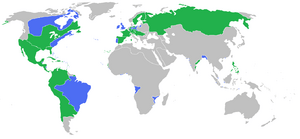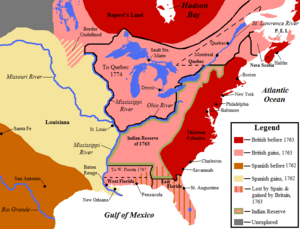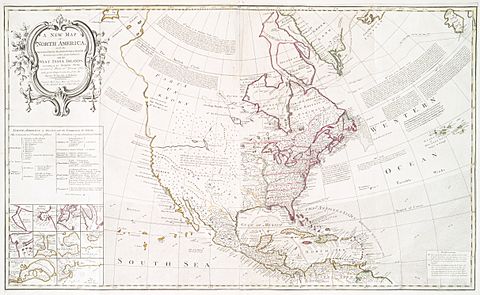Treaty of Paris (1763) facts for kids

The combatants of the Seven Years' War as shown before the outbreak of war in the mid-1750s.
Great Britain, Prussia, Portugal, with allies France, Spain, Austria, Russia, with allies |
|
| Context | End of the Seven Years' War (known as the French and Indian War in the United States) |
|---|---|
| Signed | 10 February 1763 |
| Location | |
| Negotiators |
|
| Signatories | |
| Parties | |
The Treaty of Paris, also known as the Treaty of 1763, was signed on 10 February 1763 by the kingdoms of Great Britain, France and Spain, with Portugal in agreement, after Great Britain and Prussia's victory over France and Spain during the Seven Years' War.
The signing of the treaty formally ended the Seven Years' War, known as the French and Indian War in the North American theatre, and marked the beginning of an era of British dominance outside Europe. Great Britain and France each returned much of the territory that they had captured during the war, but Great Britain gained much of France's possessions in North America. Additionally, Great Britain agreed to protect Roman Catholicism in the New World. The treaty did not involve Prussia and Austria as they signed a separate agreement, the Treaty of Hubertusburg, five days later.
Contents
Exchange of territories
During the war, Great Britain had conquered the French colonies of Canada, Guadeloupe, Saint Lucia, Martinique, Dominica, Grenada, Saint Vincent and the Grenadines, and Tobago, the French "factories" (trading posts) in India, the slave-trading station at Gorée, the Sénégal River and its settlements, and the Spanish colonies of Manila (in the Philippines) and Havana (in Cuba). France had captured Minorca and British trading posts in Sumatra, while Spain had captured the border fortress of Almeida in Portugal, and Colonia del Sacramento in South America.
In the treaty, most of the territories were restored to their original owners, but Britain was allowed to keep considerable gains. France and Spain restored all their conquests to Britain and Portugal. Britain restored Manila and Havana to Spain, and Guadeloupe, Martinique, Saint Lucia, Gorée, and the Indian factories to France.
In return, France recognized the sovereignty of Britain over Canada, Dominica, Grenada, Saint Vincent and the Grenadines, and Tobago.
France also ceded the eastern half of French Louisiana to Britain; that is, the area from the Mississippi River to the Appalachian Mountains. France had already secretly given Louisiana to Spain in the Treaty of Fontainebleau (1762), but Spain did not take possession until 1769. Spain ceded East Florida to Britain. In addition, France regained its factories in India but recognized British clients as the rulers of key Indian native states and pledged not to send troops to Bengal. Britain agreed to demolish its fortifications in British Honduras (now Belize) but retained a logwood-cutting colony there. Britain confirmed the right of its new subjects to practise Catholicism.
France lost all of its territory in mainland North America except for the territory of Louisiana west of the Mississippi River. France retained fishing rights off Newfoundland and the two small islands of Saint Pierre and Miquelon, where its fishermen could dry their catch. In turn, France gained the return of its sugar colony, Guadeloupe, which it considered more valuable than Canada. Voltaire had notoriously dismissed Acadia as quelques arpents de neige (a few acres of snow).
Louisiana question
The Treaty of Paris is frequently noted as France giving Louisiana to Spain. However, the agreement to transfer had occurred with the Treaty of Fontainebleau (1762), but it was not publicly announced until 1764. The Treaty of Paris gave Britain the east side of the Mississippi (including Baton Rouge, Louisiana, which was to be part of the British territory of West Florida). New Orleans, on the east side, remained in French hands (albeit temporarily). The Mississippi River corridor in what is now Louisiana was later reunited following the Louisiana Purchase in 1803 and the Adams–Onís Treaty in 1819.
The 1763 treaty states in Article VII:
VII. In order to reestablish peace on solid and durable foundations, and to remove for ever all subject of dispute with regard to the limits of the British and French territories on the continent of America; it is agreed, that, for the future, the confines between the dominions of his Britannick Majesty and those of his Most Christian Majesty, in that part of the world, shall be fixed irrevocably by a line drawn along the middle of the River Mississippi, from its source to the river Iberville, and from thence, by a line drawn along the middle of this river, and the lakes Maurepas and Pontchartrain to the sea; and for this purpose, the Most Christian King cedes in full right, and guaranties to his Britannick Majesty the river and port of the Mobile, and every thing which he possesses, or ought to possess, on the left side of the river Mississippi, except the town of New Orleans and the island in which it is situated, which shall remain to France, provided that the navigation of the river Mississippi shall be equally free, as well to the subjects of Great Britain as to those of France, in its whole breadth and length, from its source to the sea, and expressly that part which is between the said island of New Orleans and the right bank of that river, as well as the passage both in and out of its mouth: It is farther stipulated, that the vessels belonging to the subjects of either nation shall not be stopped, visited, or subjected to the payment of any duty whatsoever. The stipulations inserted in the IVth article, in favour of the inhabitants of Canada shall also take place with regard to the inhabitants of the countries ceded by this article.
Canada question
British perspective
The war was fought all over the world, but the British began the war over French possessions in North America. After a long debate of the relative merits of Guadeloupe, which produced £6 million a year in sugar, and Canada, which was expensive to keep, Great Britain decided to keep Canada for strategic reasons and to return Guadeloupe to France. The war had weakened France, but it was still a European power. British Prime Minister Lord Bute wanted a peace that would not push France towards a second war.
Although the Protestant British worried about having so many Roman Catholic subjects, Great Britain wanted neither to antagonize France by expulsion or forced conversion nor French settlers to leave Canada to strengthen other French settlements in North America.
French perspective
Unlike Lord Bute, the French Foreign Minister, the Duke of Choiseul, expected a return to war. However, France needed peace to rebuild. France preferred to keep its Caribbean possessions with their profitable sugar trade, rather than the vast Canadian lands, which had been a financial burden on France. French diplomats believed that without France to keep the Americans in check, the colonists might attempt to revolt. In Canada, France wanted open emigration for those, such as nobility, who would not swear allegiance to the British Crown. Finally, France required protection for Roman Catholics in North America.
Text relating castle
Article IV stated:
IV. His Most Christian Majesty renounces all pretensions which he has heretofore formed or might have formed to Nova Scotia or Acadia in all its parts, and guaranties the whole of it, and with all its dependencies, to the King of Great Britain: Moreover, his Most Christian Majesty cedes and guaranties to his said Britannick Majesty, in full right, Canada, with all its dependencies, as well as the island of Cape Breton, and all the other islands and coasts in the gulph and river of St. Lawrence, and in general, every thing that depends on the said countries, lands, islands, and coasts, with the sovereignty, property, possession, and all rights acquired by treaty, or otherwise, which the Most Christian King and the Crown of France have had till now over the said countries, lands, islands, places, coasts, and their inhabitants, so that the Most Christian King cedes and makes over the whole to the said King, and to the Crown of Great Britain, and that in the most ample manner and form, without restriction, and without any liberty to depart from the said cession and guaranty under any pretence, or to disturb Great Britain in the possessions above mentioned. His Britannick Majesty, on his side, agrees to grant the liberty of the Catholick religion to the inhabitants of Canada: he will, in consequence, give the most precise and most effectual orders, that his new Roman Catholic subjects may profess the worship of their religion according to the rites of the Romish church, as far as the laws of Great Britain permit. His Britannick Majesty farther agrees, that the French inhabitants, or others who had been subjects of the Most Christian King in Canada, may retire with all safety and freedom wherever they shall think proper, and may sell their estates, provided it be to the subjects of his Britannick Majesty, and bring away their effects as well as their persons, without being restrained in their emigration, under any pretence whatsoever, except that of debts or of criminal prosecutions: The term limited for this emigration shall be fixed to the space of eighteen months, to be computed from the day of the exchange of the ratification of the present treaty.
Dunkirk question
During the negotiations that led to the treaty, a major issue of dispute between Britain and France had been over the status of the fortifications of the French coastal settlement of Dunkirk. The British had long feared that it would be used as a staging post to launch a French invasion of Britain. Under the 1713 Treaty of Utrecht, the British had forced France to concede extreme limits on those fortifications. The 1748 Treaty of Aix-la-Chapelle had allowed more generous terms, and France constructed greater defences for the town.
The 1763 treaty had Britain force France to accept the 1713 conditions and to demolish the fortifications that had been constructed since then. That would be a continuing source of resentment to France, which would eventually have that clause overturned in the 1783 Treaty of Paris, which brought an end to the American Revolutionary War.
Reactions
When Lord Bute became the British prime minister in 1762, he pushed for a resolution to the war with France and Spain since he feared that Great Britain could not govern all of its newly-acquired territories. In what Winston Churchill would later term a policy of "appeasement," Bute returned some colonies to Spain and France in the negotiations.
Despite a desire for peace, many in the British Parliament opposed the return of any gains made during the war. Notable among the opposition was former Prime Minister William Pitt, the Elder, who warned that the terms of the treaty would lead to further conflicts once France and Spain had time to rebuild and later said, "The peace was insecure because it restored the enemy to her former greatness. The peace was inadequate, because the places gained were no equivalent for the places surrendered." The treaty passed by 319 votes to 65.
The Treaty of Paris took no consideration of Great Britain's battered continental ally, Frederick II of Prussia, who was forced to negotiate peace terms separately in the Treaty of Hubertusburg. For decades after the signing of the Treaty of Paris, Frederick II decried it as a British betrayal.
The American colonists were disappointed by the protection of Roman Catholicism in the Treaty of Paris because of their own strong Protestant faith. Some have called it one reason for the breakdown of American–British relations that led to the American Revolution.
Effects on French Canada

The article provided for unrestrained emigration for 18 months from Canada. However, passage on British ships was expensive. A total of 1,600 people left New France by that clause but only 270 French Canadians. Some have claimed that to be part of British policy to limit emigration.
Article IV of the treaty allowed Roman Catholicism to be practiced in Canada. George III agreed to allow Catholicism within the laws of Great Britain. British laws then included various Test Acts to prevent governmental, judicial and bureaucratic appointments from going to Roman Catholics. Roman Catholics were believed to be agents of the Jacobite pretenders to the throne, who normally resided in France and were supported by the French regime. This was relaxed in Quebec to some degree, but top positions such as governorships were still held by Anglicans.
Article IV has also been cited as the basis for Quebec often having its unique set of laws that are different from the rest of Canada. There was a general constitutional principle in the United Kingdom to allow colonies taken through conquest to continue their own laws. That was limited by royal prerogative, and the monarch could still choose to change the accepted laws in a conquered colony. However, the treaty eliminated that power because by a different constitutional principle since terms of a treaty were considered paramount. In practice, Roman Catholics could become jurors in inferior courts in Quebec and argue based on principles of French law. However, the judge was British, and his opinion on French law could be limited or hostile. If the case was appealed to a superior court, neither French law nor Roman Catholic jurors were allowed.
Many French residents of what are now Canada's Maritime Provinces, called Acadians, were deported during the Great Expulsion (1755–63). After the signing of the peace treaty guaranteed some rights to Roman Catholics, some Acadians returned to Canada. However, they were no longer welcome in English Nova Scotia. They were forced into New Brunswick, which is a bilingual province today as a result of that relocation.
Much land previously owned by France was now owned by Britain, and the French people of Quebec felt greatly betrayed at the French concession. Commander-in-Chief of the British Jeffrey Amherst noted that, "Many of the Canadians consider their Colony to be of utmost consequence to France & cannot be convinced... that their Country has been conceded to Great Britain."
See also
 In Spanish: Tratado de París (1763) para niños
In Spanish: Tratado de París (1763) para niños


